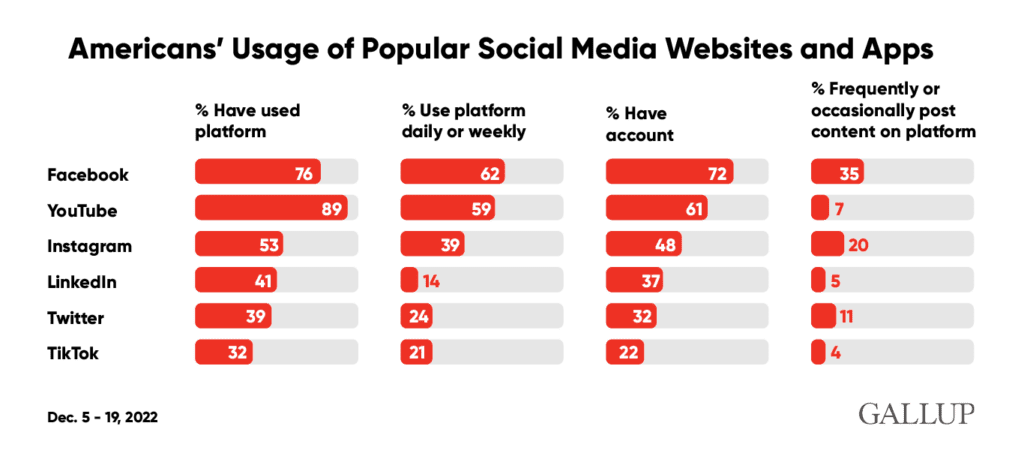Americans are inundated with social media. Every website we visit likely pushes us to its social media channels and vice versa. According to a Gallup post, here are some stats for Americans using the most popular social media platforms:

Reaching target customers and engaging with existing ones involve the use of social media. This can be an exhaustive task with ever-changing algorithms, knowing what content will actually reach customers and how to gauge the ROI on these endeavors.
Using social media for your business will encompass the decision of which type of social media to use: organic or paid. In this article, we will discuss the differences between the two (actually three, but we’ll get to that) and which one is best for your business. So let’s take a look.
Organic
In simplest terms, organic social media is any post shared that doesn’t involve any cost to increase reach and engagement. Organic social is all about building your community gradually and engaging with them directly.
Benefits:
- It’s free.
- It’s possible to create free campaigns using custom hashtags
- It’s perceived as more authentic
- It can help manage customer relationships
- It can help create brand loyalty
- It can help create a sense of community
Disadvantages:
- It’s a bit of a shot in the dark as very few people see the organic content you share — generally just 2% of your followers. So it is not a reliable way to increase sales or drive traffic for a specific marketing objective
- Algorithms can be tricky, as they are constantly changing
- It can take a long time to reach goals
- It can often become a place for customers to vent about poor customer experiences, which makes it important to continuously monitor comments and be prepared with a plan for resolving issues
Paid
Paid social media is exactly what it sounds like. You pay to have your content shared, just like an ad, so that your desired targets see the content that you would like them to see. One form of paid media is boosting organic posts so that you can make sure people see your content. Then there is true paid media, where you pay money and choose from various ad types across the marketing funnel.
Some ad units are designed for high-level brand awareness so that people can learn about who you are and what you do. Consideration ad units are designed to deliver additional information about your product or service so consumers can learn more and advance further down your purchase funnel. And conversion level tactics are generally more straightforward and focus on getting customers to take a final action to buy or use your product. Depending on your goals and KPIs, a paid social media campaign can be customized to reach a specific audience and achieve marketing objectives.
Benefits:
- It’s the best way to achieve reach and expand your audience
- You can optimize content for specific goals to drive efficiency and results
- Creative can be crafted for a specific target at a specific level of the marketing funnel
- You are guaranteed the right people will see your content or message vs. organic, where only 1% of followers may see it
- Various custom ad units allow you different types of layouts and options not available as organic posts
Disadvantages:
- Costs more than organic
- Ad-like content can be perceived as less authentic on social, although people have become used to seeing ads on social just like in other mediums
What are some approaches to take with organic and paid social media?
Whether you want to focus on organic social or paid social, the approach to using either varies quite a bit. The types of tactics you use for organic social media are generally very different from how you utilize a paid social media campaign.
Organic Social Media Tips
In general, organic social media is seen as a great way to interact with fans, share content, monitor comments, and methodically grow your following. To succeed, it takes time, the willingness to test and learn and the ability to stay very close to your audience through close community management.
You can employ various tactics to help grow your fan base and keep your followers engaged.
1. Use social listening.
This allows you to understand what people are already saying and posting about your brand. It’s an inexpensive and effective way to monitor conversations and be a part of conversations already happening. It can be used to monitor positive sentiment, and negative sentiment, which is equally important. For instance, you might find a consumer posting about a negative experience with your product or service. Through quick intervention and conversation, you have the opportunity to right a wrong and turn an unhappy customer into a lifelong fan. You can also interact with fans and drive loyalty and engagement.
2. Mine and repost user-generated content.
Through social listening, tagging and hashtag monitoring, you can find posts that fans are already sharing about you. One great tactic is to repost or share that content on your channel and credit the person who created it while acknowledging the content in a relevant way. Fans love attribution, and it’s one of the simplest and most effective organic tactics that any community manager can do to garner more engagement.
3. Be creative and take some calculated risks.
Since only 1% of your followers see your content in some cases, you want to post content that has a good chance of being shared and spread organically. That means keeping tabs on trends, being creative, and having a willingness to test and learn to see what resonates. Make sure your content is on strategy, of course, and stays true to your brand, but don’t be afraid to have a little fun and experiment.
4. Contests.
Contests are another easy way to drive engagement. You have to be careful, though, as contests often attract people who are really only there for the freebies and not really interested in interacting with your content beyond the occasional chance to win.
5. Take advantage of different types of posts and opportunities.
From reels and polls to opportunities to interact live, each platform offers different flavors and types of posts that you can utilize. Not only does it keep your content fresh, it can create new opportunities to engage and grow your audience when done right.
Paid Social Media Tips
With paid social, you can guarantee that current fans and potential new followers see your content depending on how you target. In addition, each social channel offers a variety of ad units to choose from that offer different types of creative opportunities. At Brandon, we find we get the best results when we construct a full funnel paid social media campaign. This means placing ads and creating content designed for each level of the marketing funnel including awareness, consideration and conversion-focused content. Platforms like Facebook and Instagram have become very adept at making it easy to guide a customer from simply discovering your brand to making a purchase or driving a specific action. This of course brings us to our first tip:
1. Utilize full funnel paid social campaigns.
Start with awareness units to help fans discover your brand and learn about who you are. Next, follow up with consideration ads that help your potential customer get more details and information while diving a layer deeper into what you’re all about. Then, push your follower past the tipping point to take an action with an offer, deal or other incentive to help close the deal. While you don’t have to utilize the full funnel to be successful, it can increase your odds for success when done right.
2. Take advantage of all the different types of paid social media units.
With paid social, you have access to ad types that go beyond the basic organic social media posts you can make. A little investigation uncovers a variety of ways to interact beyond an image or a video. For instance, Facebook offers storefront collection ads that really stand out in a customer’s feed by offering a unique interface and the chance to share multiple products at once without a carousel. That’s just the tip of the iceberg, though. Paid social media offers lots of unique and eye-catching ways to get your product out there, so dive in and see what’s right for you.
4. Be creative.
Just like any form of advertising, you want to come up with ideas that are going to attract and appeal to your audience. But on social media, it’s even more important. You’re competing side by side with content people want from friends, family, celebrities and ultra-popular influencers. So it’s important to make your ads relevant, interesting, eye-catching and/or meaningful if you want people to pay attention. That means being willing to take some risks that you might not take with say, a :30 TV spot.
5. Testing and Learning.
Paid social media can be optimized in real time based on what content is performing best with your target. So it’s always a good idea to create different versions and messages so that you have the chance to see what works the best for your current and future campaigns.
So Which One Is Best?
The answer lies somewhere in between. Organic and paid each have their advantages. Utilizing a hybrid approach allows for leveraging the power of both paid and organic social. As algorithms continue to limit the organic reach, it forces companies to invest in paid social opportunities to increase their audience reach. So a balanced approach can often be the best approach. It all depends on your goals, your budgets, your KPIs and your brand.
Does your company have a social media marketing plan? If so, are you seeing an ROI on your efforts? As a fully integrated marketing firm, Brandon can cover these bases — and lots more — for your brand. As one of only 24 certified brand strategy consultancies in the nation, we are experts in creating and implementing successful social media strategies and content for paid social and organic. Reach out to our team of marketing professionals today to see how we can help you with your social media needs.

